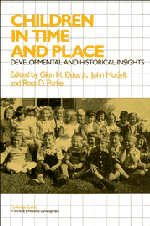Book contents
- Frontmatter
- Contents
- Preface
- Acknowledgments
- List of contributors
- Part I A proposal
- Part II Historical and life transitions
- 2 America's home front children in World War II
- 3 Rising above life's disadvantage: From the Great Depression to war
- 4 Child development and human diversity
- Part III Life transitions across historical time
- Part IV The cross-disciplinary collaboration
- Bibliography
- Author index
- Subject index
3 - Rising above life's disadvantage: From the Great Depression to war
Published online by Cambridge University Press: 03 May 2011
- Frontmatter
- Contents
- Preface
- Acknowledgments
- List of contributors
- Part I A proposal
- Part II Historical and life transitions
- 2 America's home front children in World War II
- 3 Rising above life's disadvantage: From the Great Depression to war
- 4 Child development and human diversity
- Part III Life transitions across historical time
- Part IV The cross-disciplinary collaboration
- Bibliography
- Author index
- Subject index
Summary
In one life span, Americans had moved from scarcity to abundance, from sacrifice to the freedom made possible by prosperity.
Glen H. Elder, Jr. (1974, p. 296)Life-course continuities from childhood across the adult years seem all too expectable in American life, a predictable outcome without mystery. Until recently, social scientists have given little attention to the timing of historical events in lives and their biographical influences. As Everett Hughes once noted (1971, p. 124), “Some people come to the age of work when there is no work; others when there are wars.” For others the timetable may offer a better match between life stage and historical stage, whether increasing or decreasing hardship or prosperity. At issue here is the synchronization between life history and social history and the subsequent ripple effects of that match or mismatch through adult life.
The synchrony between individual life stage and historical time for Americans born during the early 1920s minimized vulnerability to the Great Depression; those cohorts were too old to be wholly dependent on hard-pressed families in the 1930s and too young to face a stagnant labor market when they were coming of age. However, they were just the right age to be mobilized into World War II and to experience the economic recovery it prompted (Elder, 1974). This global war counteracted the impact of the Great Depression for members of this cohort, just as it ended the depression generally.
- Type
- Chapter
- Information
- Children in Time and PlaceDevelopmental and Historical Insights, pp. 47 - 72Publisher: Cambridge University PressPrint publication year: 1993
- 10
- Cited by

